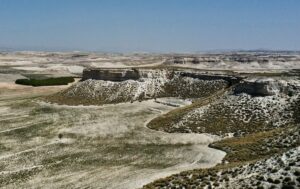 default
default The province of Granada in southeastern Spain is perhaps best known for its namesake capital city, Granada, which draws thousands of tourists every year to see the iconic Alhambra World Heritage site, among the many other spectacular Moorish architectural wonders of the city. The province also features mountain areas such as the Sierra Nevada with Europe’s most southerly ski resort, as well as the popular beach resorts of the Costa Granadina.
Less known to the general public and the tourist crowd, however, is a geological wonder called the Guadix-Baza Basin. It is a wonder because, through erosion and other natural activity over geologic time, it has revealed a rich and complete series of sediments with a fossil record dated from the Miocene to the Pleistocene. The paleontological faunal remains have drawn scientists to the area for decades. Within this semi-arid Basin, extraordinary events began to unfold in the 1970’s that really placed the Basin’s little village of Orce on the world’s map…….
Orce Man
It was in 1976 and 1979 when the late Josep Gibert i Clols, a paleontologist and geologist, conducted the first field surveys of the region surrounding Orce. Here, he found a remarkable series of fossil-bearing sediments. His son, Luis Gibert, who accompanied him at only 10 years old, described the experience. “As a geologist he [my father] knew that the Baza basin, where Orce is located, was a good target for new early Pleistocene discoveries because this region used to have an extensive lake and the shores of the lakes are good places to preserve fossils and evidences of human activities.”
What Josep was exploring near Orce were the shores of an ancient Pleistocene paleo-lake.
“I explored the region with my father looking for new sites,” continued Luis, “We had lunch with Tomas and his wife, Mariana [local residents and friends], at their house-cave, and we sieved sediments to collect small mammals [fossils] to give an approximate age to the sites in the Salar Valley near Tomas cave. That was a productive trip and new paleontological levels along the Vélez Valley were found.” Luis, following in the professional footsteps of his father, eventually became an active explorer of the region and now holds a professorship at the University of Barcelona.
____________________________
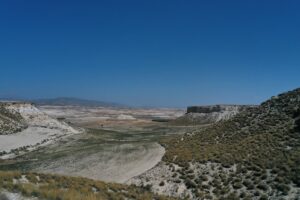
The Orce landscape. Northwards view from Barranco de los Conejos of the Early Pleistocene succession at Orce. The bottom of the valley is about 2 million years old and the top is about 1 million years old. Courtesy Luis Gibert
____________________________
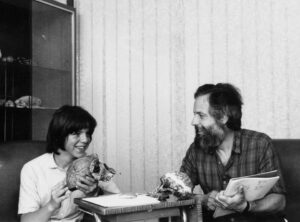
Josep and his son Luis. Courtesy Luis Gibert
____________________________
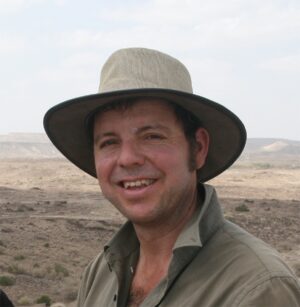
Luis Gibert today. Courtesy Luis Gibert
____________________________
But it was in 1982 when the most extraordinary finds emerged in the same region at a site near the village of Venta Micena. Josep had organized and conducted the first of succeeding excavations of the sediments here with a team of high school students. Among the fossil finds were what he identified as cranial fragments of an infant hominin species of the Homo genus, the genus to which humans belonged. The fragments included two parietal bones and an occipital bone with an endocranial crest, all found within the context of sediments containing early Pleistocene fossilized fauna initially dated to more than 1 million years ago. This would make the hominin find, in association with the faunal finds, the oldest such human ancestral remains in Western Europe.
“I remembered that my father was skeptical while other colleagues were very enthusiastic,” said Luis. “He was skeptical because if this was confirmed it would break a scientific paradigm, which proposed that humans left Africa and reached Europe very late, at around 0.6Ma. The preliminary chronology based on the fauna for this skull suggested an age older than 1 Million years, which represented a much older age than accepted [by most scholars] in 1982. So human remains in Europe older than 1Ma for sure would be controversial, as usually happens in paleoanthropology each time there is a new important discovery”.
The remains were henceforth nick-named in the popular literature as ‘Orce Man’.
But Orce Man was too old and the fossil identification too sketchy for many scholars’ taste.
Until 1995….
The Conference and More
Scholars disputed the finds at Venta Micena as hominin, including the suggested dating at over 1 million years ago. According to Luis, changing this environment became much easier after the presentations and deliberations at a major meeting of the minds in late 1995.
“The first challenge was to convince the administrative and scientific community that there was human presence at Orce older that 1Ma,” said Luis. “This was achieved during the international conference in 1995 where more than 300 scientists from 18 countries met at the small town of Orce. Participants were very excited about the sites and the finds. After that event, Orce appeared in National Geographic Magazine, Orce was named the Spanish Olduvai (Zihlman, A.L. & Lowenstein 1996), and scientists that attended the meeting, including Prof. Phillip V. Tobias from South Africa, Nobel Award nominated for his description of Homo habilis, supported the human presence at Venta Micena”.
__________________________
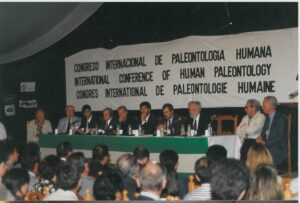
The conference. Courtesy Luis Gibert
__________________________
The finding of two hominin humeral shafts, a limited lithic assemblage, and evidence for the processing of animal tissues with stone tools added to the story of Venta Micena. Additionally, finds at two other nearby sites within the same approximate geologic horizon expanded upon the picture that was slowly emerging for the region. The sites of Barranco León-5 and Fuente Nueva 3 yielded what were identified as two deciduous human molars, thousands of stone tools characterized as belonging to the Oldowan industry (similar to those found at Olduvai Gorge in Tanzania), and cut marks on animal bones. Oldowan tools are considered the second oldest stone tool industry produced and used by hominins in the archaeological record, beginning around 2.9 million years ago in Africa.
To help confirm the human presence and the legitimacy of the Homo descriptor for the fossils, two separate laboratories carried out immunological testing on residual protein samples extracted from the fossils. Their results showed that the fossils did indeed belong to the hominin Homo genus.
Finally, as remarked by the famous British archaeologist Derek Roe about the finds, as stated in a 1996 article published in Current Anthropology:
“….whether or not the disputed bones were those of Homo, the finds of undoubted artifacts in situ at Fuente Nueva 3 and Barranco Leon made it perfectly clear that humans had been present in the area during the Lower Pleistocene….”*
___________________________
To read the rest of this article, subscribe to Popular Archaeology Magazine as a Premium Subscriber (a nominal $9.00 a year).
____________________________
Advertisement

EXPLORE THE ANCIENT ETRUSCANS IN PERSON!
Experience a unique, up-close-and-personal hike among ancient hilltop towns in central Italy. You will walk the sensational countryside of the regions of Umbria and Tuscany, soaking in important sites attesting to the advanced Etruscan civilization, forerunners of the ancient Romans; imposing architectural and cultural remains of Medieval Italy; local food and drink; and perhaps best of all — spectacular scenic views! Join us in this collaborative event for the trip of a lifetime!



